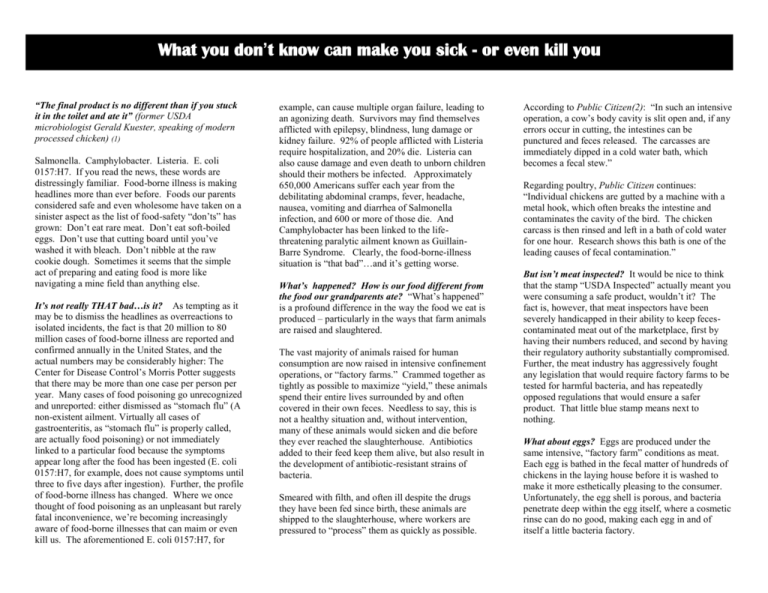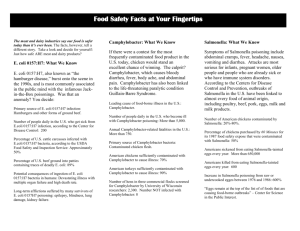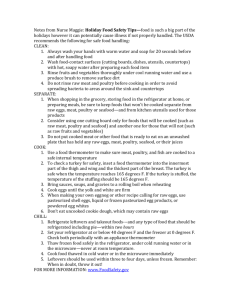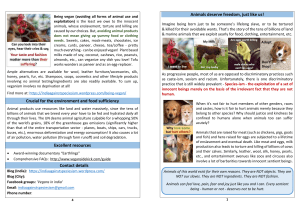Food-Borne Disease
advertisement

What you don’t know can make you sick - or even kill you “The final product is no different than if you stuck it in the toilet and ate it” (former USDA microbiologist Gerald Kuester, speaking of modern processed chicken) (1) Salmonella. Camphylobacter. Listeria. E. coli 0157:H7. If you read the news, these words are distressingly familiar. Food-borne illness is making headlines more than ever before. Foods our parents considered safe and even wholesome have taken on a sinister aspect as the list of food-safety “don’ts” has grown: Don’t eat rare meat. Don’t eat soft-boiled eggs. Don’t use that cutting board until you’ve washed it with bleach. Don’t nibble at the raw cookie dough. Sometimes it seems that the simple act of preparing and eating food is more like navigating a mine field than anything else. It’s not really THAT bad…is it? As tempting as it may be to dismiss the headlines as overreactions to isolated incidents, the fact is that 20 million to 80 million cases of food-borne illness are reported and confirmed annually in the United States, and the actual numbers may be considerably higher: The Center for Disease Control’s Morris Potter suggests that there may be more than one case per person per year. Many cases of food poisoning go unrecognized and unreported: either dismissed as “stomach flu” (A non-existent ailment. Virtually all cases of gastroenteritis, as “stomach flu” is properly called, are actually food poisoning) or not immediately linked to a particular food because the symptoms appear long after the food has been ingested (E. coli 0157:H7, for example, does not cause symptoms until three to five days after ingestion). Further, the profile of food-borne illness has changed. Where we once thought of food poisoning as an unpleasant but rarely fatal inconvenience, we’re becoming increasingly aware of food-borne illnesses that can maim or even kill us. The aforementioned E. coli 0157:H7, for example, can cause multiple organ failure, leading to an agonizing death. Survivors may find themselves afflicted with epilepsy, blindness, lung damage or kidney failure. 92% of people afflicted with Listeria require hospitalization, and 20% die. Listeria can also cause damage and even death to unborn children should their mothers be infected. Approximately 650,000 Americans suffer each year from the debilitating abdominal cramps, fever, headache, nausea, vomiting and diarrhea of Salmonella infection, and 600 or more of those die. And Camphylobacter has been linked to the lifethreatening paralytic ailment known as GuillainBarre Syndrome. Clearly, the food-borne-illness situation is “that bad”…and it’s getting worse. What’s happened? How is our food different from the food our grandparents ate? “What’s happened” is a profound difference in the way the food we eat is produced – particularly in the ways that farm animals are raised and slaughtered. The vast majority of animals raised for human consumption are now raised in intensive confinement operations, or “factory farms.” Crammed together as tightly as possible to maximize “yield,” these animals spend their entire lives surrounded by and often covered in their own feces. Needless to say, this is not a healthy situation and, without intervention, many of these animals would sicken and die before they ever reached the slaughterhouse. Antibiotics added to their feed keep them alive, but also result in the development of antibiotic-resistant strains of bacteria. Smeared with filth, and often ill despite the drugs they have been fed since birth, these animals are shipped to the slaughterhouse, where workers are pressured to “process” them as quickly as possible. According to Public Citizen(2): “In such an intensive operation, a cow’s body cavity is slit open and, if any errors occur in cutting, the intestines can be punctured and feces released. The carcasses are immediately dipped in a cold water bath, which becomes a fecal stew.” Regarding poultry, Public Citizen continues: “Individual chickens are gutted by a machine with a metal hook, which often breaks the intestine and contaminates the cavity of the bird. The chicken carcass is then rinsed and left in a bath of cold water for one hour. Research shows this bath is one of the leading causes of fecal contamination.” But isn’t meat inspected? It would be nice to think that the stamp “USDA Inspected” actually meant you were consuming a safe product, wouldn’t it? The fact is, however, that meat inspectors have been severely handicapped in their ability to keep fecescontaminated meat out of the marketplace, first by having their numbers reduced, and second by having their regulatory authority substantially compromised. Further, the meat industry has aggressively fought any legislation that would require factory farms to be tested for harmful bacteria, and has repeatedly opposed regulations that would ensure a safer product. That little blue stamp means next to nothing. What about eggs? Eggs are produced under the same intensive, “factory farm” conditions as meat. Each egg is bathed in the fecal matter of hundreds of chickens in the laying house before it is washed to make it more esthetically pleasing to the consumer. Unfortunately, the egg shell is porous, and bacteria penetrate deep within the egg itself, where a cosmetic rinse can do no good, making each egg in and of itself a little bacteria factory. Keep yourself safe What can I do to protect myself and my family from food-borne illness? Avoid animal products. While it is possible to contract food poisoning from non-animal foods, particularly raw foods that have come in contact with cutting boards or counters that have been contaminated by meat, the risk is miniscule compared with the risk incurred by eating meat, dairy products and eggs. You can greatly reduce your risk of contracting a serious food-borne disease by adopting a plant-based diet, or, at the very least, by cutting down radically on the amount of meat, eggs and dairy products you consume. Exercise caution. If cutting out all animal products is not possible for you at this time, please at least take the health warning seriously. This is a very real problem. Cook ALL meat and eggs thoroughly. Avoid products made with raw eggs, such as cookie dough, eggnog and some ice creams. Don’t use “raw” (unpasteurized) milk or soft cheeses commonly made from raw milk. Disinfect cutting boards and countertops before using them to prepare raw fruits or vegetables, and wash your hands thoroughly after handling raw meat or eggs. These are hazardous substances – treat them as such. Educate yourself. Read The Food Revolution, by John Robbins for an in-depth look at the reality of food production, and to learn how your choices really can affect your health and the health of the world in which we live. (1) (2) Behar, Richard, and Kramer, Michael, “Something Smells Fowl,” Time, October 17, 1994, pp 42-5. Public Citizen Foundation, “A Citizen’s Guide to Fight Food Irradiation,” (2000), p. 13-6. © 2002 by EarthSave International. The Power To Make A Difference is On Your Plate Join EarthSave to Stay Informed and to Educate Others EarthSave’s greatly needed programs are actively helping people reclaim their health and restore our planet. By joining EarthSave, you learn how your food choices protect and improve your quality of life, and you become an active player in healing the environment. For membership or information, call 1-800-362-3648. EarthSave promotes food choices that are healthy for people and for the planet. We educate, inspire and empower people to shift toward a plantbased diet, and to take compassionate action for all life on Earth. Local EarthSave chapters throughout the world help further these goals by teaching people in their communities about healthy, compassionate and sustainable food choices. For information on the chapter nearest you, or for information on starting a chapter, call us at 1-800-362-3648 or email us at information@earthsave.org. FOOD-BORNE DISEASE Animal Products: Unsafe on Any Plate Protect yourself from chronic diseases. Plant foods supply the nutrients necessary to promote good health EarthSave ® Healthy People Healthy Planet ™ EarthSave ® Healthy People Healthy Planet ™ PO BOX 96 New York, NY 10108 800-362-3648/718-459-7503 Email: information@earthsave.org www.earthsave.org EarthSave International’s Educational Series










